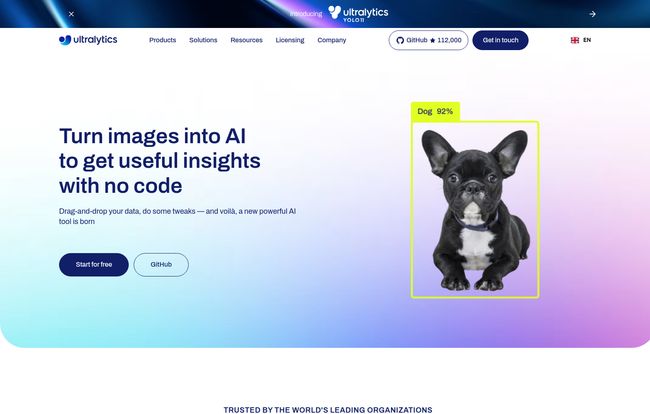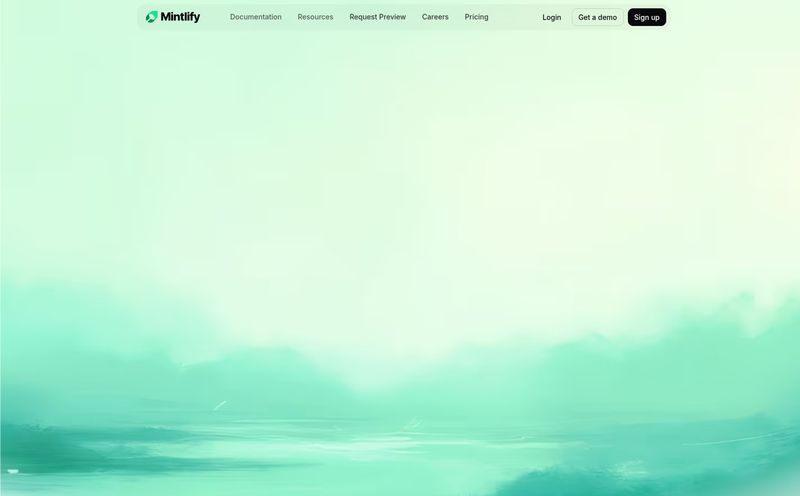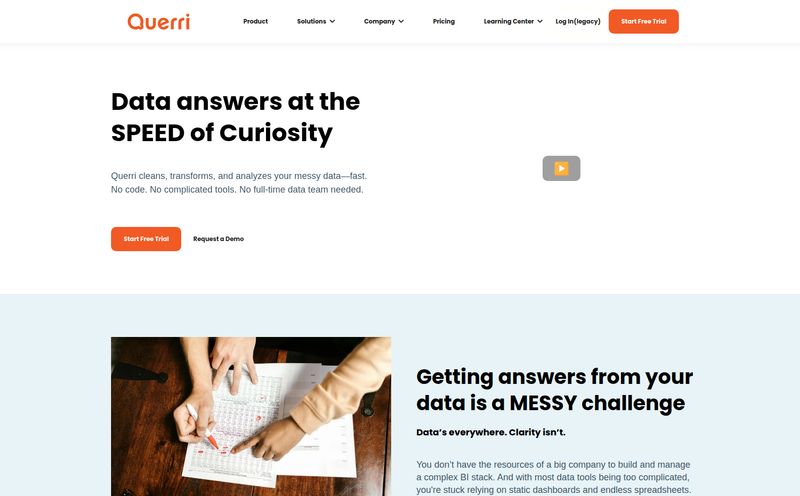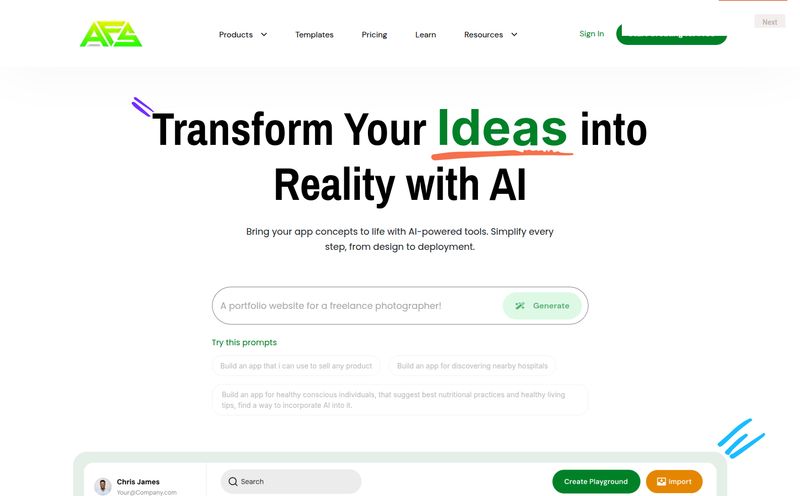For years, the world of computer vision and AI has felt a bit like a secret club. You needed a PhD in machine learning, a deep understanding of Python, and a server rack humming away in your basement just to get a basic object detection model off the ground. I’ve spent countless nights wrestling with TensorFlow dependencies and cursing at CUDA drivers. It’s a high barrier to entry, and it’s kept a lot of brilliant ideas on the whiteboard.
Then, every once in a while, a tool comes along that makes you stop and say, 'wait a minute'. A tool that feels less like a complex scientific instrument and more like a creative canvas. For me, that's the feeling I get looking at Ultralytics HUB. It promises to turn complex vision AI into something anyone can build, with no code. A bold claim. But with the legendary YOLO models powering it, I had to see for myself if it was just marketing fluff or the real deal.
So, What Exactly is Ultralytics HUB?
Think of it this way: You know how platforms like Squarespace or Webflow let you build a gorgeous, functional website without writing a line of HTML or CSS? Ultralytics HUB aims to do the exact same thing, but for creating artificial intelligence. It's a comprehensive platform, an entire ecosystem, designed to take you from a folder of images to a fully deployed, working AI model that can see and understand the world.
It’s not just a simple model builder. It’s the whole pipeline. You can upload and manage your datasets (the images your AI will learn from), train your models using either their cloud infrastructure or your own hardware, and then export those models into a dozen different formats to use in your app, on a website, or on an edge device. The whole process, start to finish, all in one place. That, right there, is a huge deal.
The Powerhouse Under the Hood: A Quick Nod to YOLO
Before we go further, we have to talk about the engine driving this thing: YOLO. If you've been anywhere near the computer vision space, you've heard of YOLO (You Only Look Once). It’s a family of AI models famous for its incredible speed and accuracy in detecting objects in real-time. Ultralytics is the company behind the most recent and powerful iterations, like YOLOv8. So when you use the HUB, you’re not getting some generic, watered-down AI. You’re getting access to state-of-the-art technology. It’s like they handed you the keys to a Formula 1 car (the YOLO model) but built an incredibly user-friendly dashboard and automatic transmission (the HUB) around it.

Visit Ultralytics
A Walkthrough of My Favorite Features
Okay, let's get into the good stuff. What does it actually feel like to use this platfrom? Here are a few things that really stood out to me during my exploration.
The Genuine No-Code Experience
This is the headline feature, and they nail it. The interface is clean, intuitive, and visually driven. The process of starting a new project, uploading data, and kicking off a training job feels… simple. It removes the intimidation factor. You don't need to configure a YAML file or fight with command-line arguments. You click buttons. You drag sliders. It’s an approach that opens the door for product managers, designers, researchers, and entrepreneurs to build their own proofs-of-concept without needing to hire a dedicated ML engineer from day one.
Dataset Management That Doesn’t Make You Want to Cry
Anyone who's built a model knows that 80% of the work is wrangling data. It's the least glamorous part, but the most important. Ultralytics HUB seems to understand this pain. The tools for uploading, visualizing, and annotating your images are built right in. Seeing your data laid out, being able to inspect it, and preparing it for training without having to juggle three different software tools is a massive quality-of-life improvement.
Flexible Training Options for Every Budget
This is a big one. When it's time to actually 'teach' your model, the HUB gives you a choice. You can use their Ultralytics Cloud, which is perfect if you don't have a powerful GPU on hand. Or—and this is awesome—you can use your own hardware by connecting it as an 'Agent'. This means if you have a gaming PC with a decent graphics card, you can use the platform's easy interface to manage training jobs running on your own machine. For free! This flexibility is fantastic for everyone from students on a budget to businesses with specific hardware requirements.
Let's Talk Money: Breaking Down the Ultralytics Pricing
Pricing can make or break a tool like this. Too expensive, and it remains in the hands of the corporate giants. Too convoluted, and nobody signs up. Ultralytics has adopted a pretty straightforward tiered model that seems to cater to just about everyone.
| Plan | Price | Best For | Key Features |
|---|---|---|---|
| HUB Free | Free | Students, hobbyists, and testing | 20GB Storage, Train with Agents, Export Models |
| HUB Pro | $20 /month | Professionals, freelancers, and small teams | 200GB Storage, Cloud Training ($20 credit), Inference API, Teams |
| HUB Enterprise | Coming Soon | Large organizations with specific needs | Unlimited Storage, On-Premise Options, Source Code Access |
I’ve gotta say, the Free plan is incredibly generous. 20GB of storage and the ability to train on your own hardware is more than enough to learn the ropes and build some seriously cool projects. The Pro plan, at $20 a month, is a no-brainer for anyone doing this professionally. The extra storage, team features, and the API access are easily worth the price of a few coffees. The monthly cloud training credits are a nice touch too. The fact that the Enterprise plan is still 'coming soon' is a bit of a tease, but it shows they have a roadmap for supporting major corporate clients.
The Good, The Bad, and The... Coming Soon
No tool is perfect, right? After my deep dive, here's my balanced take.
What I love is pretty clear: the intuitive no-code workflow is a triumph, making vision AI truly accessible. The raw power of the underlying YOLO models gives it serious credibility, and the pricing, especially the free tier, is fantastic. It successfully democratizes a very complex field.
On the flip side, the caveats are minor but worth mentioning. For the Free and Pro plans, support is community-based. This is standard practice, but if you run into a tricky issue, you're heading to the forums, not a dedicated support line. And while the Pro plan offers cloud training, it's based on credits, so heavy users might see costs go beyond the monthly subscription fee. Finally, some of the most exciting features for large businesses, like on-premise deployment, are part of the still-to-be-released Enterprise plan. It’s a small thing, but something to be aware of if you’re a big company looking to adopt it tomorrow.
Frequently Asked Questions about Ultralytics
What is Ultralytics best used for?
It's designed for vision AI tasks. Think object detection (finding cars in a video), image classification (is this a cat or a dog?), and instance segmentation (outlining the exact shape of every person in a crowd). It's for any project where you need a machine to 'see' and understand images or video.
Do I need to know how to code to use Ultralytics HUB?
Nope! That's the main attraction. The HUB is a no-code platform, meaning you can manage data, train models, and test them all through a graphical interface. You'll only need coding skills if you want to integrate the final exported model into your own custom application.
Is Ultralytics YOLO free?
This can be a bit confusing. The YOLOv8 models themselves are open-source with an AGPL-3.0 license. You can download the code and run it yourself if you have the expertise. Ultralytics HUB is the platform that makes using those models incredibly easy, and that platform has both free and paid tiers.
How does the pricing work for cloud training?
On the Pro plan, you get $20 in monthly credits. Training models on the Ultralytics Cloud consumes these credits. It’s a pay-as-you-go system that gives you access to powerful hardware without having to own it. The free credits are often enough for several training runs on moderately sized datasets.
Can I use my own computer for training?
Absolutely. This is one of the best features of the Free plan. You can connect your own computer (Windows, Mac, or Linux) as a HUB 'Agent' and use its GPU to train models, all managed from the HUB web interface.
Final Thoughts: A Big Step in the Right Direction
So, is Ultralytics HUB the revolution I was hoping for? In a word, yes. It's one of the most promising and well-executed attempts I've seen at smashing that high barrier to entry I mentioned at the beginning. It takes the rocket science out of computer vision and puts powerful tools into the hands of creators, innovators, and problem-solvers.
It’s not going to replace ML engineers, but it will empower them to work faster. And more importantly, it will empower a whole new generation of builders who have the vision, but not the coding background, to bring their ideas to life. For the curious, the free plan is a playground you have to check out. For the professional, the Pro plan is a powerful and affordable addition to your toolkit. This feels like the future, and I'm excited to see what people build with it.
Reference and Sources
- Ultralytics Official Website
- Ultralytics HUB Pricing Page
- Original YOLO Research Paper (for the academics!)



